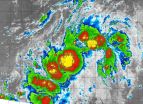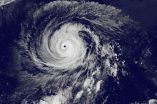(Press-News.org) DURHAM, N.C. -- As governments and industries expand their use of high-decibel seismic surveys to explore the ocean bottom for resources, experts from eight universities and environmental organizations are calling for new global standards and mitigation strategies.
Their goal is to minimize the amount of sound the surveys produce and reduce risks the surveys and other underwater human noise pollution poses to vulnerable marine life.
Firms and agencies conducting the surveys would benefit from these new measures, the experts assert, because instead of having to navigate an assortment of rules that vary by nation or region, they would have a uniform set of standards to follow.
"In recent years, we've seen an increase in the use of seismic surveys for oil and gas exploration and research, and for establishing national resource claims on ever-larger geographic scales. Surveys are now occurring in, or proposed for, many previously unexploited regions including parts of the Arctic Ocean and off the U.S. Atlantic coast," said Douglas P. Nowacek, an expert on marine ecology and bioacoustics at Duke University.
"The time has come for industries, governments, scientists and environmental organizations to work together to set practical guidelines to minimize the risks," he said.
Nowacek and his colleagues published their recommendations in a peer-reviewed paper today (Sept. 1) in the journal Frontiers in Ecology and the Environment.
Seismic survey impulses are among the loudest noises humans put into the oceans, and in some cases can be detected more than 2,500 miles away. The increase in ocean noise they cause can mask sounds whales and other species rely on to communicate, navigate, find food or avoid predators. Long-term exposure to the noise can also lead to chronic stress and disorientation in animals, and auditory damage.
To reduce these risks, the new paper recommends that ocean noise be recognized globally as a pollutant - something the European Union already recognizes - and managed through a revision to the existing International Convention on the Prevention of Pollution from Ships. This will allow the establishment of consistent, scientifically based standards and monitoring programs for ocean noise levels, Nowacek said.
Using empirical data from this monitoring and from ongoing field studies the convention would support, scientists could more thoroughly assess surveys' cumulative long-term impacts on marine life and identify areas where seismic activities should be prohibited or temporarily limited to protect important habitats or vulnerable populations.
Wider use of multi-client surveys could also cut risks. By collecting data simultaneously for two or more firms or agencies, these surveys significantly reduce the number of surveys required in a region, without forcing clients to share proprietary data. They've been successfully tested in Norway.
Emerging technologies could further reduce a survey's acoustic footprint. Many of these technologies, including the marine vibrator - which conducts surveys using a steady pulse of low-pressure sound waves over a longer period - are "not that far away from industrial scale use," Nowacek said.
The need to implement these new protective measures and scale up these technologies is urgent, he stressed. As sea ice in the Arctic Ocean rapidly diminishes, bordering nations are eyeing new underwater oil and gas exploration and research prospects there. Increased activity is also proposed for lower latitudes.
"Survey permits are now being considered for oil and gas exploration along the U.S. East Coast that would allow surveys to occur as close as three miles from the coast. However, the current draft of the U.S. Bureau of Ocean Energy Management's five-year plan for East Coast oil and gas exploration allows oil and gas lease areas to be no closer than 50 miles offshore. That's a pretty big difference," Nowacek said. "While gathering some data from beyond a lease area is necessary, allowing these industries to survey to within three miles of the coast is excessive."
INFORMATION:
Nowacek is the Repass-Rodgers University Associate Professor of Conservation Technology at Duke's Nicholas School of the Environment and Pratt School of Engineering.
He published the new paper with authors from Cornell University, Humu Labs, the University of St. Andrews, the Wildlife Conservation Society, the Natural Resources Defense Council, the University of California at Santa Cruz, Southall Environmental Associates, and Duke.
CITATION: "Marine Seismic Surveys and Ocean Noise: Time for Coordinated and Prudent Planning," Douglas P. Nowacek, Christopher W. Clark, David Mann, Patrick J.O. Miller, Howard C. Rosenbaum, Jay S. Golden, James Kraska, Michael Jasny, Brandon L. Southall, Sept. 1, 2015, in Frontiers in Ecology and the Environment. http://dx.doi.org/10.1890/130286
BUFFALO, N.Y. - Social interaction could be the mechanism that allows animals living in groups to synchronize their activities, whether it's huddling for warmth or offering protection from predators.
This social presence affects the daily rhythm of activity and rest, and the larger the group, the greater the likelihood of synchronization, according to a study published recently in the journal Biology Letters.
"At least in mice, and perhaps in other animals, this study shows quite dramatic synchrony amongst groups of animals that can only be explained by social interactions," ...
BUFFALO, N.Y. - Economic well-being for low-income families in the U.S. is often determined by federal measures that establish basic requirements for essentials such as food, shelter and clothing, but a new study by a University at Buffalo research team suggests that such a definition is unrealistically narrow.
To help families move out of poverty, the existing perspective of economic well-being and its short-term focus on basic needs should reflect possibilities for long-term stability, including a savings plan, rather than day-to-day survival, says Yunju Nam, an associate ...
To arrange for an interview with a researcher, please contact the Communications staff member identified at the end of each tip. For more information on ORNL and its research and development activities, please refer to one of our media contacts. If you have a general media-related question or comment, you can send it to news@ornl.gov.
MATERIALS - Solar bake test for NASA ...
To test an instrument for a spacecraft that will fly closer to the sun than any before, engineers at Oak Ridge National Laboratory and the University of California-Berkeley used ORNL's powerful ...
BLOOMINGTON, Ind. -- In her hit single, Carly Rae Jepsen may have sung, "Here's my number, so call me maybe." But according to a new research study from Indiana University, she might be more successful in finding love if she asked him to send her an email.
The research, which has been accepted for publication in the journal Computers in Human Behavior, suggests that, in this digital age, an email can be more effective in expressing romantic feelings than leaving a voicemail message.
Previous research and conventional wisdom suggested the opposite, that a voicemail message ...
September 1, 2015 - What's the "safe" amount of fat to remove in patients undergoing liposuction? Rather than a hard-and-fast rule, the answer depends on the patient's body mass index (BMI), according to a report in the September issue of Plastic and Reconstructive Surgery®, the official medical journal of the American Society of Plastic Surgeons (ASPS).
"Our study shows that liposuction is associated with a very low complication rate, with major complications occurring in less than 1 in 1,000 patients," comments ASPS Member Surgeon John Y.S. Kim of Northwestern ...
ANN ARBOR--Studies using yeast genetics have provided new, fundamental insights into the cell-division cycle, researchers at the University of Michigan Life Sciences Institute report.
Findings published Aug. 31 in the journal eLife show that an organelle known as the vacuole, which performs a variety of cellular housekeeping functions, plays an essential role in the initiation of the cell-division cycle.
The cell-division cycle, also known simply as the cell cycle, is the series of events inside a cell that leads to its division.
"The yeast vacuole has a counterpart ...
In use for more than a century, inhaled anesthetics like nitrous oxide and halothane have made modern surgery possible. Now, in experiments in mice, researchers at Johns Hopkins and elsewhere have added to evidence that certain so-called "volatile" anesthetics -- commonly used during surgeries -- may also possess powerful effects on the immune system that can combat viral and bacterial infections in the lung, including influenza and pneumonia.
A report on the experiments is published in the September 1 issue of the journal Anesthesiology.
The Johns Hopkins and University ...
Tropical Depression 14E was born in the Eastern Pacific Ocean early on September 1 when NASA-NOAA's Suomi NPP satellite passed overhead and looked at it in infrared light.
Infrared light shows temperature, which is helpful in determining cloud top temperatures of the thunderstorms that make up a tropical cyclone line Tropical Depression 14E (TD 14E). The colder the storm, the higher they stretch into the troposphere (lowest layer of the atmosphere) and the stronger the storms tend to be.
On September 1 at 0900 UTC (5 a.m. EDT), NASA-NOAA's Suomi NPP satellite passed ...
Hurricane Ignacio is staying far enough away from the Hawaiian Islands to not bring heavy rainfall or gusty winds, but is still causing rough surf. Infrared satellite data on September 1 shows that wind shear is adversely affecting the storm and weakening it.
The Atmospheric Infrared Sounder or AIRS instrument that flies aboard NASA's Aqua satellite gathers infrared data that reveals temperatures. When NASA's Aqua satellite passed over Ignacio on September 1 at 11:41 UTC (7:41 a.m. EDT), the AIRS data and showed some high, cold, strong thunderstorms surrounded the center ...
EUGENE, Ore. - Sept. 1, 2015 - The University of Oregon's Kelly Sutherland has seen the future of under-sea exploration by studying the swimming prowess of tiny jellyfish gathered from Puget Sound off Washington's San Juan Island.
In a paper with four colleagues in the Sept. 2 issue of the journal Nature Communications, Sutherland details how a tiny type of jellyfish - colonial siphonophores - swim rapidly by coordinating multiple water-shooting jets from separate but genetically identical units that make up the animal.
Information on the biomechanics of a living organism ...


